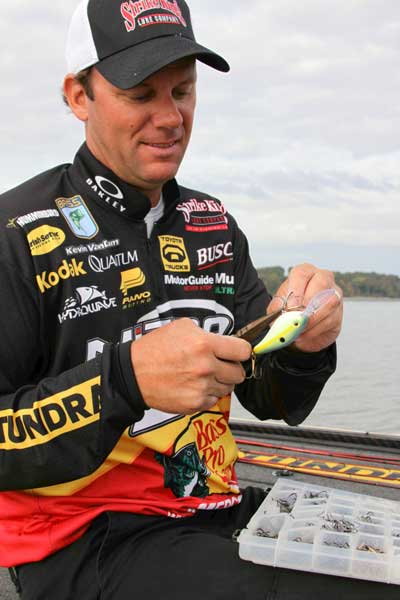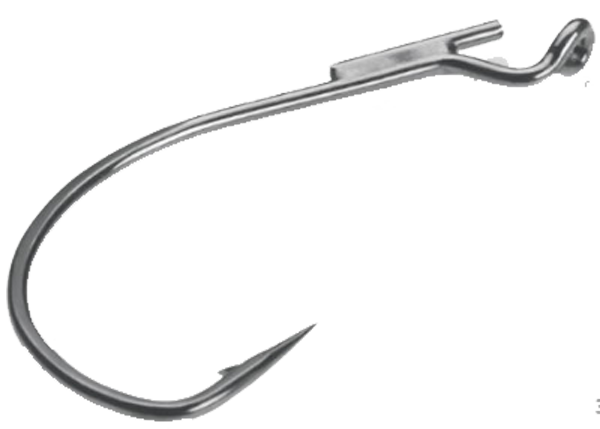By Kevin VanDam
 KVD up-sizes his hooks whenever possibleWinter is a good time to inventory your terminal tackle.
KVD up-sizes his hooks whenever possibleWinter is a good time to inventory your terminal tackle.
KVD up-sizes his hooks whenever possible
Mustad, one of my sponsors, has done such a good job of providing an assortment of premium hooks for so many applications that I use those exclusively. Im really excited about the new Grip Pin Series that offer a well-designed bait keeper that keeps your soft bait from sliding down the hook shaft.
Here are the terminal tackle choices and sizes I recommend for the different baits we use on Michiana lakes and rivers:
Hooks
Pitchin/flippin: For pitching/flipping, I use a 4/0 Grip Pin straight shank with a Strike King Rodent or Strike King Rage Craw for flipping docks or grass in our lakes.
Soft jerkbaits/stickworms: I use the offset, wide gap Grip Pin for bigger bodied baits, like the Caffeine Shad (5/0) and the Ocho (3/0), the latter which is a six-sided Senko-style bait.
Mustad Grip Pin hook for plastics
 Mustad Grip Pin hook for plasticsWorms: The light-wire, straight shank Grip Pin is ideal for finesse worms. I will use the 2/0 or 3/0, depending upon the size of the worm. On bigger worms casting, I may go to 4/0 or even bigger.
Mustad Grip Pin hook for plasticsWorms: The light-wire, straight shank Grip Pin is ideal for finesse worms. I will use the 2/0 or 3/0, depending upon the size of the worm. On bigger worms casting, I may go to 4/0 or even bigger.
Drop-shot: For baits like the Strike King Dream Shot or a KVD 4-inch finesse worm, I use the 1/0 Mustad Grip Pin Edge hook for rigging weedless.
I will nose-hook smaller baits and use the No. 2 Double Wide Drop-Shot hook for most applications.
Crankbaits: I replace new crankbaits with extra short shank trebles because they allow me to go to a bigger hook without fear of them tangling.
For example, on the ½-ounce Strike King Red Eye Shad (lipless crankbait), KVD 1.5 Square Bill, and Series 5 crankbaits, Ill use two No. 2 short shank triple grips instead of the stock hooks.
On smaller crankbaits, (Series 1, 3 and 1.0), I go with two No. 4 KVD Extra Short Shanks.
Remember that you cant upsize hooks on baits that are balance-sensitive, like topwaters and small jerkbaits. Mustad offers a KVD Round Bend version for lures like that.
Sinkers
I only use Strike Kings Tour Grade Tungsten sinkers these days. Tungsten sinkers are more compact, have a better sink rate and youll hook more fish because the smaller profile doesnt force the fishs mouth open on hooksets as often as larger sinkers will.
Texas and Carolina rigging: Ive always been an advocate of using heavier sinkers than most anglers. If Im pitching grass beds 8 feet deep or less, Ill use ½ and ¾ ounce, leaning toward the ¾ ounce most of the time. Our lakes generally are clear and I believe a faster fall triggers more bites. I may even go to a 1 ounce if fishing deeper.
However, I use 1/8 ounce when I believe a slower fall is more effective, or if using light line and trying to finesse the fish into biting. I rarely use in-between sizes of weights.
Also the only time I peg a sinker is if Im fishing a lighter weight and trying to punch through the grass. It keeps the weight with the bait.
Drop-shotting: The tear-drop design is ideal for fishing weeds because it doesnt hang up as badly as others. I carry 1/8, ¼ and 3/8 ounce.
Snaps
Snaps make it easier to change colors or lure sizes, especially if you have a limited number of rods. When I know the crankbait bite is on, I generally have multiple rods rigged with different baits and different line sizes and will tie direct. But I do use snaps on occasion.
When you use one, choose a premium brand with a double locking mechanism to assure it wont open accidentally. Also, you dont need to oversize the snap unless youre fishing with heavy braid. A smaller snap that allows the bait to move freely is better because it catches less in the grass.